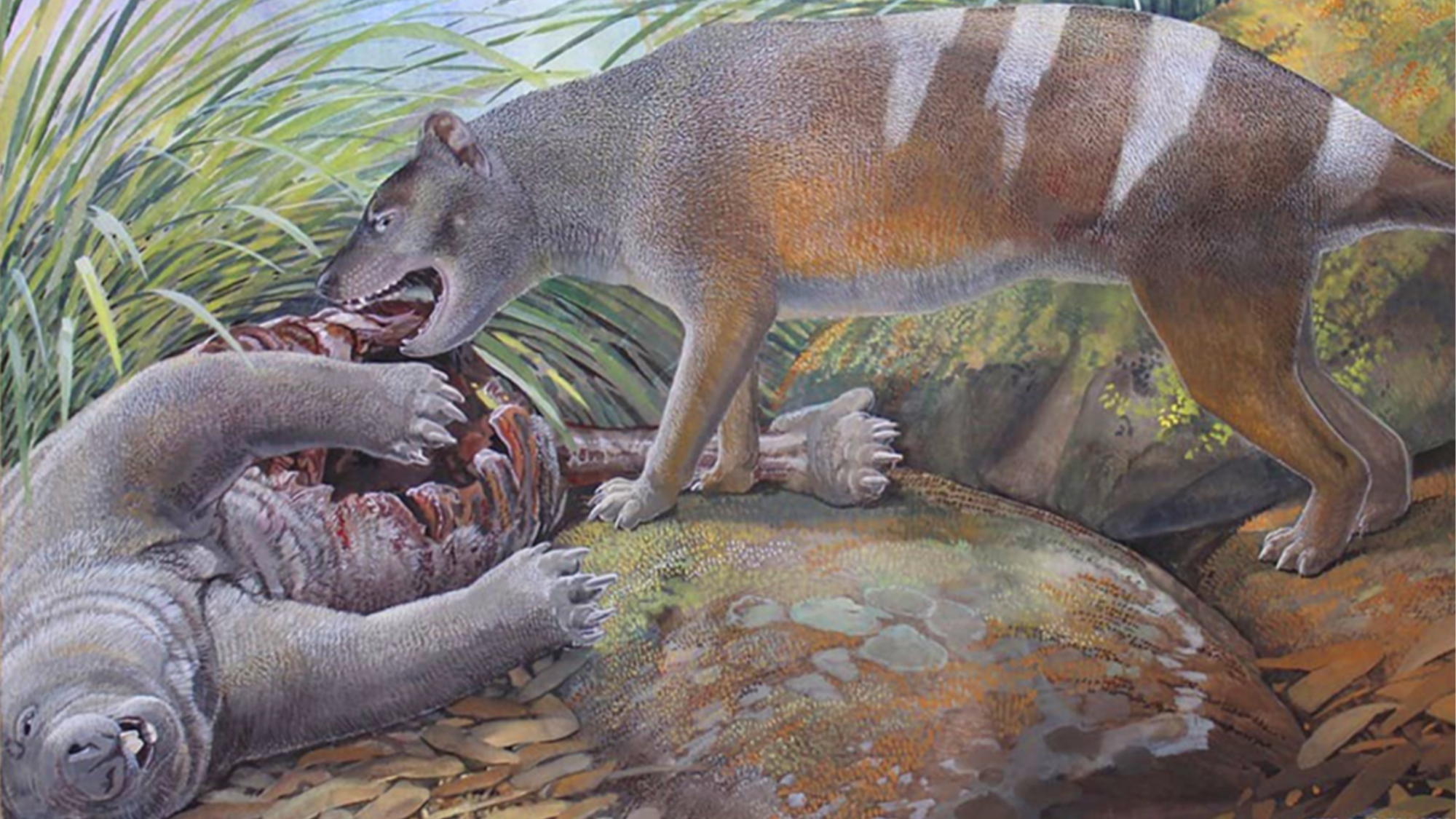Three new ancient species of Tasmanian tigers have been discovered in Australia. Now extinct, these newly uncovered marsupials include one with a jawbone that would have allowed it to crush its prey’s bone and teeth, a major carnivore, and the closest known relative of the last Tasmanian tiger species. The findings are detailed in a study published September 6 in the Journal of Vertebrate Paleontology and coincides with the 88th anniversary of the death of one of the last known Tasmanian tigers.
Reptiles and marsupials fight for dominance
Tasmanian tigers are a group of extinct marsupials called Thylacines that roamed New Guinea, the Australian mainland, and Tasmania about 23 to 25 million years ago during the late Oligocene Epoch. They were about the size of a dog and are known for distinctive stripes and sharp claws.
According to the team on this new study, these newly described species are the oldest members of the Thylacines family that scientists have found.
[Related: A genetics startup wants to bring the Tasmanian tiger back from extinction.]
“The once suggested idea that Australia was dominated by reptilian carnivores during these 25 million-year-long intervals is steadily being dismantled as the fossil record of marsupial carnivores, such as these new thylacinids, increases with each new discovery,” Timothy Churchill, a study co-author and PhD student at the University of New South Wales (UNSW) Vertebrate Palaeontology Lab, said in a statement emailed to Popular Science.
The new species were found in the fossil-rich Riversleigh World Heritage Area in Queensland, where numerous fossils of turtles, fish, snails, crocodiles, lizards, pythons, birds, and several types of mammals have been uncovered.
“The diversity of mammalian carnivores at Riversleigh during this period rivals that seen in any other ecosystem, including the great mammalian carnivore radiation that developed in South America,” said Churchill.
Tasmanian Jaws?
Badjcinus timfaulkneri is the largest of these news species. It weighed between 15 to 24 pounds, about the size of a large Tasmanian devil. B. timfaulkneri had an extremely thick jawbone that would have allowed it to eat its prey’s teeth and bones–also like the living Tasmanian devil.
This species is related to the much smaller, roughly six pound previously discovered Badjcinus turnbulli. Until now, this smaller species was the only other undoubted thylacinid known from the late Oligocene. The team found a lower jawbone and isolated first molar of B. timfaulkneri in the Hiatus Site, a fossil deposit within the park that is even older than the wider Riversleigh’s White Hunter Site where B. turnbulli was previously found.
A close relative
The second new species is Nimbacinus peterbridgei. Weighing in at about eight pounds, it was roughly the size of a Maltese terrier. Scientists found a nearly complete lower jaw bone from these species at the White Hunter Site.
This species was a predator that likely focused on eating small mammals and other diverse prey species in ancient forests. Species of Nimbacinus also appear to be more closely related to the Tasmanian tiger than other thylacinids from this time. Nimbacinus peterbridgei is likely the oldest direct ancestor of the Tasmanian tiger currently known to science.
Major meat eater
Ngamalacinus nigelmarveni weighed about 11 pounds or the size of a Red fox. The blades of its lower molars are long with deep “meat cutting” notches which suggest that it was likely highly carnivorous. The team suspects it was likely more carnivorous than other thylacinids of a similar size.
Australia’s National Threatened Species Day
Australia’s annual National Threatened Species Day is on September 7. The somber day is dedicated to more than 2,000 plant and animal species that are currently listed as “threatened.” It also commemorates the death of Benjamin, one of the last known Tasmanian tigers on September 7, 1936.
Tasmanian tigers first disappeared from the Australian mainland about 2,000 years ago. The National Australia Museum speculates that over-hunting and the introduction of the dingo, led to the first wave of Tasmanian tiger extinction.
[Related: The last Tasmanian tiger’s remains were finally found—in a cupboard.]
Europeans began to colonize the island of Tasmania—an island about 150 miles south of Australia–during the late 19th and early 20th centuries. Colonizers incorrectly blamed the marsupials for killing chickens and sheep, and thylacines were slaughtered by the thousands. Benjamin a Thylacinus cynocephalus–died in captivity at the Beaumaris Zoo in Hobart, Tasmania 88 years ago. That last remaining lineage ultimately survived for more than 25 million years until that ended in the 1930s.
In December 2022, researchers from the Tasmanian Museum and Art Gallery in Hobart found the remains of the last known Tasmanian tiger in a museum cupboard. The remains belonged to an older female animal that had been captured by a trapper from the Florentine Valley and sold to Beaumaris Zoo before it died sometime after Benjamin. The skeleton and skin of the specimen were then stashed away in the cupboard at the museum, due to its “somewhat shady” acquisition and the experts lost track of it.

